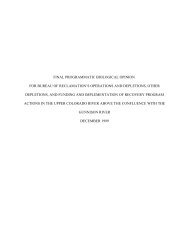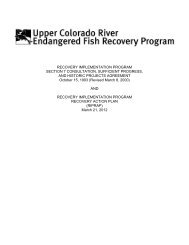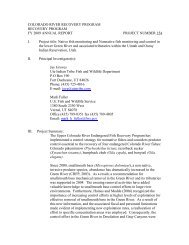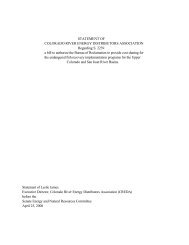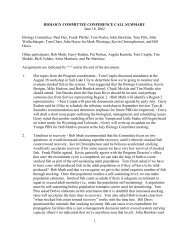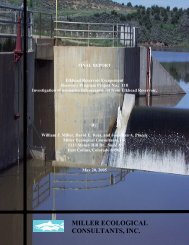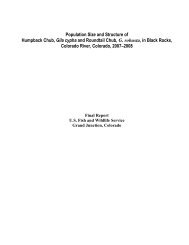K. R. Bestgen, K. A. Zelasko, and G. C. White. Monitoring ...
K. R. Bestgen, K. A. Zelasko, and G. C. White. Monitoring ...
K. R. Bestgen, K. A. Zelasko, and G. C. White. Monitoring ...
You also want an ePaper? Increase the reach of your titles
YUMPU automatically turns print PDFs into web optimized ePapers that Google loves.
Colorado River abundance, survival, <strong>and</strong> capture probabilities.—During 2005, sampling<br />
resulted in capture of 426 stocked razorback suckers in the Colorado River, of which 145 (34%)<br />
were adults (> 400 mm TL); a total of 12 adult individuals were recaptured among the five<br />
sampling passes. Based on adult capture data, model M t + length (a model that allows capture<br />
probabilities to vary with sampling pass <strong>and</strong> with fish length) produced an abundance estimate of<br />
1,066 fish, although precision was low (95% confidence limits = 377–3,703) <strong>and</strong> likely a result<br />
of relatively low probabilities of capture of 0.018 to 0.057 for fish that averaged 437 mm TL<br />
(Osmundson <strong>and</strong> Seal 2009). Using the same model, an abundance estimate of 2,137 was<br />
derived for all sizes of razorback suckers present (SE = 348, CV = 16%; 95% confidence interval<br />
1,576–2,958).<br />
<strong>Zelasko</strong> et al. (2009; 2010; 2011) found similarly low capture probabilities for razorback<br />
suckers in both the Green <strong>and</strong> Colorado River systems, with highest capture rates coming from<br />
the largest, most easily captured fish. These data demonstrate that Colorado pikeminnow<br />
sampling can produce sufficient captures of fish to estimate population abundance but estimates<br />
are imprecise <strong>and</strong> of limited value. Additional data from multiple years of sampling, <strong>and</strong><br />
additional captures from other sampling programs will likely increase precision of those<br />
estimates because data can be borrowed across years to increase efficiency of the estimators.<br />
The point here is that abundance <strong>and</strong> survival estimates can be produced but managers will need<br />
to decide how much increased recapture effort is needed to satisfy the need for increased<br />
precision <strong>and</strong> potentially reduced bias of the estimates.<br />
Simulations to guide sampling effort <strong>and</strong> group stocking size<br />
Simulation methods. —To assist with determining the levels of sampling needed to<br />
increase precision <strong>and</strong> reduce bias of estimators, we simulated various sampling program data in<br />
program MARK (<strong>White</strong> <strong>and</strong> Burnham 1999). Recall that the overall goal of the monitoring<br />
sampling is to obtain relatively accurate <strong>and</strong> unbiased estimates of abundance, survival, or other<br />
parameters of interest, <strong>and</strong> to estimate those parameters with a relatively high level of precision.<br />
Those goals can be accomplished mainly by increasing recapture rates of marked fish, <strong>and</strong> the<br />
simulations can be used to predict effects of variations in sampling programs on accuracy <strong>and</strong><br />
precision of estimates.<br />
38



